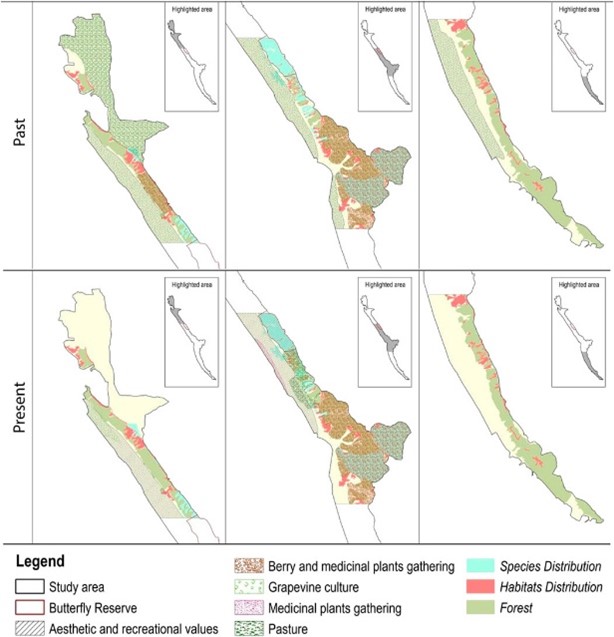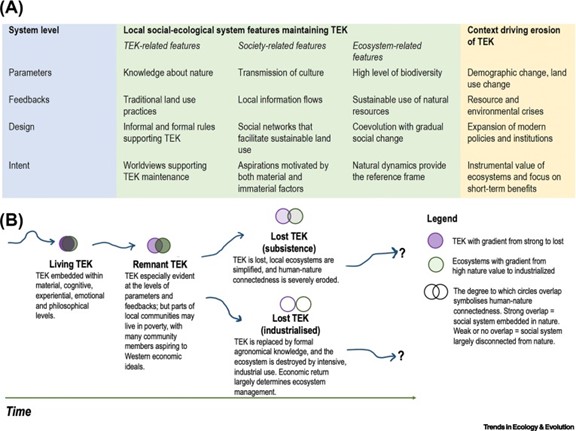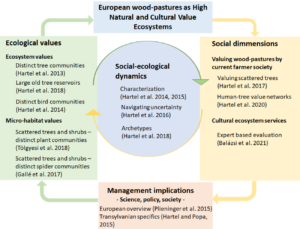In diesem Abschnitt werden die wichtigsten Veröffentlichungen über siebenbürgische Waldweiden vorgestellt. Unten werden die Veröffentlichungen unseres Teams vorgestellt. Eine Auswahl der wichtigsten internationalen Veröffentlichungen anderer Forscher zum Thema Siebenbürgische Waldweiden ist unter ‚Weitere Publikationen‘ zu finden.
Siebenbürgische Waldweiden haben sich als eng gekoppelte sozial-ökologische Systeme entwickelt. Um sie zu verstehen, sind daher sowohl disziplinäre (z.B. Ökologie, Sozialwissenschaften) als auch ganzheitliche Ansätze erforderlich. Abbildung 1 zeigt einen sozial-ökologischen Rahmen, in dem die Ergebnisse präsentiert werden. Um das Verständnis zu erleichtern, geben wir für jedes der vorgestellten Papers eine Kernaussage.
In diesem Abschnitt stellen wir die wissenschaftlichen Arbeiten vor, die während dieses Projekts entstanden sind. Der Abschnitt wird laufend aktualisiert, sobald neue Arbeiten verfügbar sind.
Hartel, T., Arghius, V., Stoican, F., Reti, K.O., Bouriaud, L. (2023). New Law for Old Trees in Romania: lessons and opportunities. Conservation Science and Practice, online early.
Key findings:
We propose the following messages for developing national Laws for LOT:
- Generate reliable knowledge about the LOT by consulting the scientific literature and implementing field research. This includes the heritage-, economic-, and ecological values of LOT.
- Perseverence in advocacy and communication. Key features of our advocacy and communication work were: inclusivity, empowerment, inspiration, presence in the local communities when needed, communication through conventional mass media and social media. These activities were continuously implemented.
- Involve translational and bridging persons who have good reputation in the level of civil society, in academic circles, and in political circles as well.
- Involve and help politicians who believe that advocacy for LOT in the Government can be part of the political career for a better environment.
Figure 1. The events that resulted in the emergence of the Romanian Law for protecting remarkable trees. Despite its weaknesses, the Law has the potential for leveraging educational, advocacy, research, and conservation projects. On the right side, the images show three remarkable oaks (with at least 450 cm girths) in open and forest landscapes. According to the Law, however, the tree from the forest is not protected.
Lindborg, R., Hartel, T., Helm, A., Prangel, E., Reitalu, T., Ripoll-Bosch, R. (2023). Ecosystem services provided by semi-natural and intensified grasslands: Synergies, trade-offs and linkages to plant traits and functional richness. Applied Vegetation Science 26: 1-10.
Key findings:
- Semi-Natural Grasslands (SNG) generate a wider range of Ecosystem Services (ES) than Intensified Grasslands (IG).
- Trade-offs exist between ES that appear more pronounced in IG between high biomass production and other ES.
- SNG are good in providing habitat for biodiversity, supporting pollination and cultural services. SNG also have a significantly wider range of plant functional traits and a higher functional richness, suggesting that the potential to supply ES in SNG is partly driven by higher number of species and their functional diversity.

Figure 1. Most important ecosystem services (ES) generated from intensified grasslands and semi-natural grasslands. The ES estimates are based partly on the existing literature and partly on the authors’ expert assessment (for those ES where the confidence term was inconclusive or unresolved. Each estimate ranges from 0 to 1, with petal sizes close to 0 meaning that delivery of that specific ES is low in relative terms. From Lindborg et al., 2023.
Morariu, S.-D., Macicasan, V., Malos, C.V., and Hartel, T. (2023) Mapping biodiversity and cultural values complemented with understanding of social dynamics provides effective means for addressing opportunities for nature conservation in a cultural landscape. Frontiers in Environmental Science 11:1112896. doi: 10.3389/fenvs.2023.1112896
Key findings:
- The current distribution of protected species and habitats in a farming landscape protected as Natura 2000 site does not overlap with the farmed areas in the past and present.
- The local community went through dramatic changes from the past to present: increased individualism weakened or lost local rules, diversifying individual aspirations, low level of collective actions and weak alignment between knowledge and aspirations and the protected area. New socio-cultural values are represented by educational activities, however, with a lack of genuine local community engagement.
- Key directions identified by interviewees for the future of the site were nature friendly activities such as tourism, biking trails, forestry, and the renewal of viticulture.

Figure 1. Map sequences of the study area presenting the land use in the past (1960s-1989) and present (in the past 5–7 years). The areas covered by pasture, viticulture, wild fruit collection and cultural ecosystem services were mapped with the help of interviewees. The habitats and species were mapped by biologist experts and the forest was extracted from CORINE land cover (see interview results for their origins). The map was split in 3 sections for better visualization. From Murariu et al., 2023.
Hartel, T., Fischer, J., Shumi, G., William, A. (2023) The Traditional Ecological Knowledge Conundrum. Trends in Ecology and Evolution 38: 211-214.
Key findings:
- The traditional ecological knowledge (TEK) is increasingly considered as being important for nature resource management.
- The social, cultural and economic aspirations, however, only rarely sustain the TEK. This results in the situation when TEK holder rural communities maintains their knowledge and practices not as a result of free option but as the result of poverty and lack of entitlements. This is what the paper defines as ‘the TEK conundrum’
- Considering the Leverage Points framework, four hypothesis for future research are presented regarding the maintenance and transmission of TEK.

Figure 1. Local and regional social-ecological, institutional, and economic contexts influencing the persistence of traditional ecological knowledge (TEK) in a social-ecological system (A), and stylised trajectory of a rural social-ecological system with respect to the maintenance of TEK (B). Source: Hartel et al., 2023.
Hartel, T., Dorresteijn, I., Klein, C., Máthé, O., Moga, C.I., Öllerer, K., Roellig, M., von Wehrden, H., Fischer, J. (2013) Wood-pastures from a traditional rural region of Eastern Europe: characteristics, biodiversity and threats. Biological Conservation, 166: 267-275.
Key findings:
- Wood-pastures increases the diversity of trees at landscape scale.
- Wood-pastures are large old tree reservoirs in traditional farming systems.
- Wood-pastures genuinely expands the tree species and functional trait diversity at landscape scale. For effective tree conservation forests and wood-pastures should be simultaneously considered.
Hartel, T., Hanspach, J., Abson, D., Mathe, O., Moga, C.I., Fischer, J. (2014) Bird communities in traditional wood-pastures with changing management in Eastern Europe. Basic and Applied Ecology 15: 385-395.
Key findings:
- Wood-pastures have distinct bird communities compared to forests and pastures without trees.
- All three landscape elements have bird species of conservation interest.
- High forests, wood-pastures and treeless pastures altogether should be considered to maximize bird species and functional diversity pool at landscape scale.
Hartel, T., Hanspach, J., Moga, C.I., Holban, L., Szapanyos, A., Tamas, R., Horvath, Cs., Reti, K.O. (2018) Abundance of large old trees in wood-pastures of Transylvania (Romania). Science of the Total Environment 613: 263-270.
Key findings:
- The abundance of large old trees belonging to different species is sensitive to different social and ecological drivers.
- Social, cultural and environmental features should be simultaneously adopted to understand the abundance and species composition of large old trees in wood-pastures.
Tölgyesi, Cs., Bátori, Z., Gallé, R., Urák, I., Hartel, T. (2018) Shrub encroachment under trees diversifies the herb layer in Romanian silvopastoral system. Rangeland Ecology and Management 71: 571-577.
Gallé R, Urák I, Nikolett G-S, Hartel T. (2017) Sparse trees and shrubs confers a high biodiversity to pastures: Case study on spiders from Transylvania. PLoS ONE 12(9): e0183465. https://doi.org/10.1371/journal.pone.0183465
The above two studies were implemented in the same system. Key messages are pooled here.
Key findings:
- Scattered trees, shrubs, treeless pastures and forest edge have distinct plant and spider communities within the same wood-pasture system.
- New spider species for Romania and over 15 spider species which are considered rare at various red lists were identified.
- Scattered trees and shrubs across the pasture increases the functional diversity in both plants and spiders across the pasture hence are key for biodiversity-production reconciliation.
Hartel, T., Nita, A., Rozylowicz, L. (2020) Understanding human-nature connections through value networks: the case of ancient wood-p15+astures from Central Romania. Sustainability Science, 15 1357–1367.
Hartel, T., KO Reti, Craioveanu, C. (2017) Valuing scattered trees from wood-pastures by farmers in a traditional rural region of Eastern Europe. Agriculture, Ecosystems and Environment, 236: 304-311.
The above two studies were implemented in the same system. Key messages are pooled here.
Key findings:
- Farmers show clear preference towards wood-pasture compared to pasture without trees.
- Mature trees on wood-pastures have mostly tangible- while large old trees have intangible values.
- Collapsed trees should be removed/cleared from pastures.
- Human-wood-pasture tree relations can be understood through the conceptual and methodological lens of network science.
Balázsi, Á., Dänhardt, J., Collins, S., Schweiger, O., Settele, J., Hartel, T. (2021) Understanding cultural ecosystem services related to farmlands: Expert survey in Europe. Land Use Policy 100, 104900
Key findings:
- Cultural Ecosystem Services (CES) are appreciated by experts but at the same time hard to quantify.
- Especially the aesthetic, cultural heritage, educational and recreational values were considered the most relevant CES subcategories.
- Interdisciplinary approaches, landscape planning and integrative science-policy approaches were perceived as the most promising methodologies to improve the CES approach for policy and management.
Hartel, T., Fischer, J., Girma, S.D., Apollinaire, W. (2023) The Traditional Ecological Knowledge conundrum. Trends in Ecology and Evolution, in press.
Paper resulted within the current DBU project.
Key findings:
- Traditional ecological knowledge (TEK) is gaining prominence among ecologists because it can help inform ecosystem management.
- Sometimes TEK is maintained not because of positive values about the environment, but because of poverty and a lack of options. The paper discuss this conundrum and present hypotheses for future research.
Hartel, T., Torralba, M., Balazsi, A., Fagerholm, N., Plieninger, T. (2018) Forum: Social-Ecological Archetypes for European Rangelands. Rangeland Ecology and Management 71: 536-544.
Key findings:
- Pastoral systems can exist in multiple social-ecological archetypes. Not all favors wood-pasture type of pastoral systems.
- Each of these archetypes may be also understood as social-ecological equilibrium states with specific sustainability challenges.
- Most of the current wood-pasture systems are in the “Aspiration misfit” archetype, where the high natural value systems are not supported by the socio-economic aspirations of the local communities.
Hartel, T., Olga Réti, K., Craioveanu, C, Gallé, R., Popa, R., Ioniţă, A., Demeter, L., Rákosy, L., Czúcz, B., (2016) Rural social–ecological systems navigating institutional transitions: case study from Transylvania (Romania). Ecosystem Health and Sustainability, 2:2, DOI: 10.1002/ehs2.1206
Key findings:
- Wood-pasture SES dynamics are exposed to the dynamics of higher (national and supranational) institutions. The panarchy framework can be useful to understand the links between local SES and higher level institutional dynamics.
- There is a SES momentum for the conservation and sustainability of Transylvanian wood-pastures.
- Historical and current management can serve as inspiration for the sustainability of wood-pastures.
Hartel, T., Plieninger, T (editors) (2014) European wood-pastures in transition: a social-ecological approach. (2014). Earthscan-Routledge. ISBN 9780815395317. 322 pages
This is an edited book on European wood-pastures.
Hartel, T., Plieninger, T., Varga, A. (2015) Wood-pastures of Europe. Pp 61-76 in Kirby, K., Watkins, Ch. „Europe`s changing woods and forests: from wildwood to managed landscapes” CABI press. ISBN : 978-1-78064-337. 363 pages.
This is a book-chapter in an edited book.
Plieninger, T., Hartel, T., Martín-López, B., Beaufoy, G., Bergmeier, E., Kirby, K., Mon-tero, M.J., Moreno, G., Oteros-Rozas, E., Van Uytvanck, J., (2015) Wood-pastures of Europe: geographic coverage, social–ecological values, conservation management, and policy implications. Biological Conservation 190, 70–79.
Hartel, T. (2015) Wood-pastures of Romania. Seminar talk at the European Parliament, link here: https://www.youtube.com/watch?v=CzSbo-D1DS8 (TH talk is from minute 29:40).


